| Wolverhampton & Walsall Railway | ||||||||||||||||||||||||||||||||||||||||||||||||||||||||||||||||||||||||||||||||||||||||||||||||||||||||||||||||
|---|---|---|---|---|---|---|---|---|---|---|---|---|---|---|---|---|---|---|---|---|---|---|---|---|---|---|---|---|---|---|---|---|---|---|---|---|---|---|---|---|---|---|---|---|---|---|---|---|---|---|---|---|---|---|---|---|---|---|---|---|---|---|---|---|---|---|---|---|---|---|---|---|---|---|---|---|---|---|---|---|---|---|---|---|---|---|---|---|---|---|---|---|---|---|---|---|---|---|---|---|---|---|---|---|---|---|---|---|---|---|---|---|
| ||||||||||||||||||||||||||||||||||||||||||||||||||||||||||||||||||||||||||||||||||||||||||||||||||||||||||||||||
The Wolverhampton and Walsall Railway was incorporated in 1865 in order to connect the city of Wolverhampton, England with nearby towns such as Walsall, Willenhall and Wednesfield.
| Wolverhampton & Walsall Railway | ||||||||||||||||||||||||||||||||||||||||||||||||||||||||||||||||||||||||||||||||||||||||||||||||||||||||||||||||
|---|---|---|---|---|---|---|---|---|---|---|---|---|---|---|---|---|---|---|---|---|---|---|---|---|---|---|---|---|---|---|---|---|---|---|---|---|---|---|---|---|---|---|---|---|---|---|---|---|---|---|---|---|---|---|---|---|---|---|---|---|---|---|---|---|---|---|---|---|---|---|---|---|---|---|---|---|---|---|---|---|---|---|---|---|---|---|---|---|---|---|---|---|---|---|---|---|---|---|---|---|---|---|---|---|---|---|---|---|---|---|---|---|
| ||||||||||||||||||||||||||||||||||||||||||||||||||||||||||||||||||||||||||||||||||||||||||||||||||||||||||||||||
The Wolverhampton and Walsall Railway was incorporated in 1865 in order to connect the city of Wolverhampton, England with nearby towns such as Walsall, Willenhall and Wednesfield.
The railway opened on 1 November 1872 and was initially operated jointly by the Midland Railway and the London and North Western Railway. The route was 8 miles long.
Although the line was initially jointly run by the London & North Western & Midland Railway companies, disagreements between the partners soon developed, and the railway was bought outright by the London and North Western Railway in 1875. A year later, the L&NWR sold the line to the Midland Railway, who made an end-on connection via the short Walsall Avoiding Line to their Sutton Park Line at the line's western terminus near Ryecroft Junction, with additional south-facing connections added into Ryecroft Junction itself, allowing Midland Railway trains from Birmingham to access either Wolverhampton or Derby - mostly via their own lines.
Originally known as the Wolverhampton, Walsall & Midland Junction Railway the Sutton Park Line had been acquired by the MR on 30 July 1874, its eastern end connecting to the former Birmingham & Derby Junction Railway line at a triangular junction near Castle Bromwich. The acquisition of both the W&WR and the W,W&MJR provided the Midland Railway with a direct route into Wolverhampton from the east of Birmingham. Thanks to the main line connection at Wolverhampton, either or both sections of the combined line were able to be used as diversionary routes during engineering works elsewhere on Birmingham's railway network.
The line started at Wolverhampton High Level, and had the following stations:
In 1878, the running powers for the Midland Railway into Wolverhampton High Level ceased, and so the company decided to build a new terminus on Wednesfield Road, just to the east of Wolverhampton Low Level. This would have led to the unusual situation of having three stations for three different companies next to each other, and an Act of Parliament to allow construction of the new station was passed on 28 June 1877. However, the London and North Western Railway also gained an Act on the same day to allow construction of the "Loop Line" between the Grand Junction Railway and Wolverhampton High Level (which would allow the LNWR access to Willenhall and Walsall via that route), and to allow the extension of the High Level station itself. This would have caused access problems for both the Low Level station, and the proposed station at Wednesfield Road. Eventually, the extension plan was dropped, and the Midland Railway managed to renegotiate the use of Wolverhampton High Level. As the proposed new terminal was no longer required, a large goods depot was built in its place which opened in November 1881. This depot was demolished in the 1990s, and is today the site of a large Royal Mail sorting office.
Later known as the Walsall to Wolverhampton Line (not to be confused with the modern Walsall to Wolverhampton Line which is the former L&NWR route), it was never particularly successful as a passenger route and enjoyed only a meagre patronage at best. Some stations were closed within only a few years of the line's opening and all passenger services were withdrawn on 5 January 1931. However, the line remained open to goods traffic until 28 September 1964 when it was divided into two sections just west of the former Bentley station by construction work commencing on the Walsall to Stafford section of the M6 motorway.
Part of the western section of the line was closed to all traffic when Short Heath goods yard closed on 7 December 1964, after which the remaining goods traffic still using the line terminated at Willenhall.
The rest of the western section was closed to all traffic on 1 November 1965 when Willenhall goods yard closed. However, the section from Heath Town Junction to Noose Lane near Willenhall was reopened in 1970, although in reality it was little more than a very long siding for steel trains to run along from the former Round Oak Steelworks to the Weldless Tube Company works. When this traffic ceased after the closure of the steelworks on 23 December 1982, the line was closed again in 1983.
The first section of track to be lifted was between Bentley and Birchills Power Station and by 1977, most of the track between Noose Lane, Willenhall and Birchills Power Station had been lifted, though the section to the west of Noose Lane was still used to serve various industrial areas. However, these remaining sections of track were progressively removed during the 1980s.
The eastern section from Ryecroft Junction remained open to serve Birchills Power Station until this traffic ceased sometime in 1978, with the line remaining disused until official closure took place on 12 May 1980. The closure of this section robbed Ryecroft Junction of being the sole surviving four-way junction on Britain's railway network.
Although all scheduled passenger services were withdrawn on 18 January 1965, the former Wolverhampton, Walsall & Midland Junction Railway remains open in 2018 from Water Orton to Ryecroft Junction for freight, with the very occasional railway enthusiasts' charter train forming the only passenger services to use the line in recent years.
The short Walsall Avoiding Line from Lichfield Road Junction to North Walsall Junction which connected both the W&WR and the W,W&MJR together was closed to all traffic in 1967.
In the 1990s, a section of the W&WR trackbed was used for the route of the A4124 Wednesfield Way.
In 2011, the trackbed from Walsall to Bentley via North Walsall was filled in due to anti-social behavior and to preserve the route for possible future use.
The line was planned to form part of the proposed '5' Ws West Midlands Metro route which would have connected Walsall, Wednesbury, Willenhall, Wednesfield and Wolverhampton but Walsall Council pulled out of the scheme due to lack of funding and the plans were dropped.
The trackbed is still preserved in readiness for part of the Midland Metro scheme. However, the original plans for Line 3 of the Midland Metro which was to run from Wolverhampton to Walsall were officially abandoned in October 2015: the line's original route being modified to run instead from Wednesbury to the Merry Hill Shopping Centre in Brierley Hill, with a later extension planned to Stourbridge via Brettel Lane.
In 2019, it was revealed that the WMCA and TfWM were looking into the feasibility of a third West Midlands Metro Line, from Wolverhampton Station to Walsall Station, via Heath Town, New Cross Hospital, Bentley Bridge, Wednesfield and Willenhall.

West Midlands Metro is a light-rail/tram system in the county of West Midlands, England. Opened on 30 May 1999, it currently consists of a single route, Line 1, which operates between the cities of Birmingham and Wolverhampton via the towns of Bilston, West Bromwich and Wednesbury, running on a mixture of reopened disused railway line and on-street running in urban areas. The line originally terminated at Birmingham Snow Hill station, but with extensions opened in 2015 and 2019, now runs into Birmingham City Centre to terminate at Library in Centenary Square. A further extensions to Edgbaston and Wolverhampton are scheduled to open during 2022.

Willenhall is a market town situated in the Metropolitan Borough of Walsall, in the West Midlands, England, with a population taken at the 2011 census of 28,480. It is situated between Wolverhampton and Walsall, historically in the county of Staffordshire. It lies upon the River Tame, and is part of the Black Country.
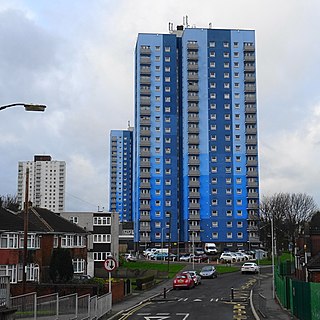
Wednesfield is a town and historic village in the City of Wolverhampton, West Midlands, England, It is 2 miles (3.2 km) east-northeast of Wolverhampton city centre, and is part of the West Midlands conurbation. It was historically within the county of Staffordshire.
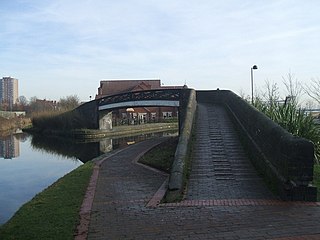
The Bentley Canal is an abandoned canal that was part of the Birmingham Canal Navigations. A very short section still exists where it joins the Wyrley and Essington Canal in Wolverhampton. From there it headed generally southeast through Willenhall and Walsall and connected with the Anson Branch and thus the Walsall Canal. The main line opened in 1843, with the Neachell Hall Branch following two years later. The branch closed in 1953 and the main line in the early 1960s.

Aston railway station serves the districts of Aston and Nechells in Birmingham, England. The passenger entrance is on Lichfield Road. The station is on the Cross-City Line and the Chase Line. It is one of two local stations for Aston Villa Football Club and near to the Aston Expressway and to Gravelly Hill Interchange.

Walsall railway station is the principal railway station of Walsall, West Midlands, England and situated in the heart of the town. It is operated by West Midlands Trains, with services provided by West Midlands Railway and from 2019, London Northwestern Railway operate a service from Rugeley to London Euston that calls at the station. The main entrance is situated inside the Saddlers Shopping Centre.

The Shrewsbury and Birmingham Railway was authorised in 1846. It agreed to joint construction with others of the costly Wolverhampton to Birmingham section, the so-called Stour Valley Line. This work was dominated by the hostile London and North Western Railway, which used underhand and coercive tactics. The section between Shrewsbury and Wellington was also built jointly, in this case with the Shropshire Union Railway.
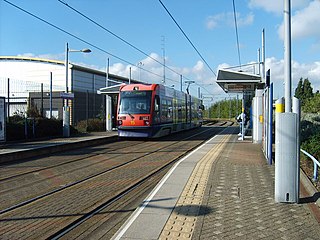
Wednesbury Great Western Street is a tram stop in Wednesbury, Sandwell, England. It was opened on 31 May 1999 and is situated on Midland Metro Line 1. The stop is next to the Midland Metro tram depot.
Bentley is an area in the Metropolitan Borough of Walsall located around Junction 10 of the M6 Motorway. It is also a rural village of houses towards its eastern sides. It shares borders with the areas of Willenhall, Beechdale, Ashmore Park, Pleck, Darlaston and Alumwell.
The South Staffordshire line is a partially mothballed and active former mainline that connects Burton-upon-Trent to Lichfield in Staffordshire and formerly then to the West Midlands towns of Walsall, Wednesbury, Dudley and Stourbridge. However, Dudley and Stourbridge were already joined to the Oxford, Worcester and Wolverhampton Railway's (OW&WR) line just north of Dudley Station. It in essence, continued to Stourbridge along with Wednesbury and Walsall.

The Walsall–Wolverhampton line is a railway line in the West Midlands, England. It connects the town of Walsall to the city of Wolverhampton. The complete line does not currently have any regular scheduled passenger services: The line's local passenger service was withdrawn in 1965, it was restored in 1998, only to be withdrawn again in 2008. At present, the main use of the line is by freight trains, and it is also used as a diversionary route when engineering works are carried out on the West Coast Main Line.
The Oxford, Worcester and Wolverhampton Railway (OW&WR) was a railway company in England. It built a line from Wolvercot Junction near Oxford to Worcester, Stourbridge, Dudley and Wolverhampton, as well as some branches.

Rushall railway station was a station on the South Staffordshire Line.

Wednesfield railway station was a station built by the Wolverhampton and Walsall Railway in 1872, and was operated by the Midland Railway from 1876 onwards. It served the Wednesfield area of Wolverhampton, and was located near to Neachells Lane.

Willenhall Stafford Street railway station was a station built by the Wolverhampton and Walsall Railway in 1872, and was operated by the Midland Railway from 1876 onwards. It served the town of Willenhall, and was located to the north of the town centre. It was originally named Willenhall Market Place.

Short Heath railway station was a station built by the Wolverhampton and Walsall Railway in 1872, and was operated by the Midland Railway from 1876 onwards. It served the area of Short Heath, to the north east of Willenhall, although it was located well to the south of Short Heath itself.
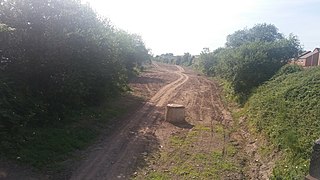
North Walsall railway station was a station built by the Wolverhampton and Walsall Railway in 1872, and was operated by the Midland Railway from 1876 onwards. It served the north of Walsall, and was located west of Bloxwich Road.
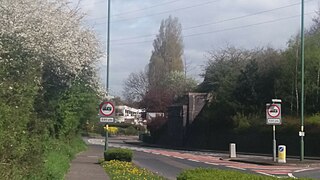
Bentley railway station was a railway station built by the Wolverhampton and Walsall Railway in 1872, and was operated by the Midland Railway from 1876 onwards. Situated on Bloxwich Lane, it served the area of Bentley, located between Willenhall and Walsall in the English West Midlands. The station closed in 1898.
Wednesfield Heath railway station was a station built on the Grand Junction Railway and opened on 4 July 1837 as Wolverhampton. It was the first railway station serving the town of Wolverhampton, and was located around a mile to the east of the city centre within the suburb of Heath Town, on Station Road. It was designated as a First Class station.

The Evesham branch line is a mostly disused English railway line running from Barnt Green via Redditch, Alcester and Evesham to Ashchurch. It was sometimes known as the Gloucester loop line of the Midland Railway.
| Wikimedia Commons has media related to Walsall to Wolverhampton Line . |